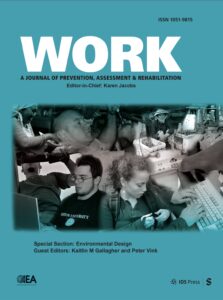Publications

Comparison of upper trapezius muscle stiffness between female assembly workers with and without myofascial trigger points
Authors: Yoon-ji Lee 1, Sung-hoon Jung 2, Jun-Hee Kim 3, Hwa-ik Yoo 3, Oh-yun Kwon 3
Affiliations:
- Department of Physical Therapy, Graduate School, Yonsei University, Wonju, Republic of Korea
- Department of Physical Therapy, Division of Health Science, Baekseok University, Cheonan, Republic of Korea
- Department of Physical Therapy, College of Software and Digital Healthcare Convergence, Laboratory of Kinetic Ergocise Based on Movement Analysis, Yonsei University, Wonju, Republic of Korea
Journal: WORK: A Journal of Prevention, Assessment and Rehabilitation - June 2025, Online First (DOI: 10.1177/10519815251351605)
-
Field & Applications:
- Medical
- Occupational Healthcare
- Balance / Postural control
- Muscle symmetry
Background: Muscle stiffness in the upper trapezius (UT) muscle is a significant parameter for evaluating myofascial trigger points (MTrPs). Because the measuring position influences UT muscle stiffness, investigating UT muscle stiffness in different working postures would be useful for evaluating and planning effective interventions for MTrPs.
Objective: To identify differences in UT muscle stiffness measured in the resting and working postures among female assembly workers, both with and without MTrPs.
Methods: Eighteen female workers with right (Rt) side UT MTrPs and 18 workers without MTrPs participated in this study. We measured UT muscle stiffness on both sides in resting and working postures using MyotonPRO. A multivariate analysis of variance was used to investigate the differences in UT muscle stiffness.
Results: In the working posture, the MTrPs group exhibited a significantly higher UT muscle stiffness on the Rt side, measuring 386.22 N/m, compared to the non-MTrPs group (335.22 N/m, p = 0.007). No significant difference was noted between the groups in the resting posture. However, the MTrPs group demonstrated greater difference in stiffness (working-resting posture) (DSWR) on the Rt side of the UT muscle (MTrPs, 62.61 N/m; non-MTrPs, 31.56 N/m; p = 0.019).
Conclusion: Clinicians should consider measuring muscle stiffness in the working posture and DSWR.
Keywords: assembly worker, muscle stiffness, myofascial trigger points, resting posture, upper trapezius, working posture
The UT muscle stiffness in the resting posture showed no notable difference between female assembly workers with and without MTrPs. However, MTrPs group demonstrated greater UT muscle stiffness than non-MTrPs group in the working posture. Furthermore, MTrPs group exhibited higher DSWR values. Therefore, we suggest that clinicians should assess muscle stiffness in both resting and working postures to effectively evaluate MTrPs.


